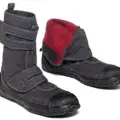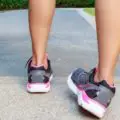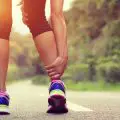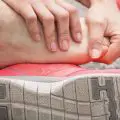*This page may contain affiliate links. When you buy through these links, we may earn a small commission at no extra cost to you.
Lately, there has been a lot of buzz about barefoot shoes and whether they’re good or bad for flat feet.
Let’s make one thing clear from the beginning. The best shoes for your feet are no shoes at all. The evolution of millions of years didn’t leave us with feet that needed shoes.
Most physical activities that require balance are performed bare feet. But, we do need something to protect those delicate soles.
That brings us to our topic. Are barefoot shoes good or bad for flat feet?
The short answer is yes; barefoot shoes help with flat feet and other foot-related problems such as high arches and plantar fasciitis.
And this is because it helps in better circulation and mobility of foot muscles.
In this article, we are going to try to explain this in detail to solve the topic once and for all.
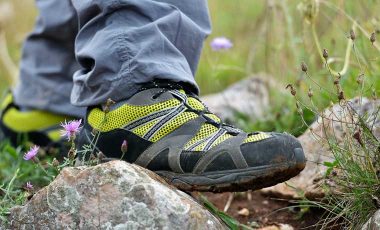
What Are Barefoot Shoes?
Barefoot shoes are like the minimalist version of conventional shoes. And are designed to provide freedom of movement while strengthening your feet.
Barefoot shoes are defined from the zero drops, little arch support, and least cushioning for the heel. They usually have a narrow sole of about 3 to 10 mm.
Resembling duck feet, their toe box is slightly wider than normal or traditional shoes. Thus providing more space for toes.
Few other qualities of the best barefoot shoes include:
- They are lighter in weight than the traditional shoe
- They provide sensory contact with the ground that we miss out on in normal shoes
- They have thin soles, but they are good enough to protect from the hazards and dirt on the ground
Some best barefoot shoes include Vibram FiveFingers KSO, Merrell Vapor Glove 3, Vibram FiveFingers V-Run and Xero shoes Prio.
6 Benefits of Wearing Barefoot Shoes
Although barefoot shoes are great to experiment with, if you are happy with your current running shoes, you should stick to them, and there is no need for a change.
But runners who suffer from foot ailments like flat feet, bunions, or other such problems should definitely try barefoot shoes.
They might help you get better performance and comfort levels.
Here are a few benefits you can expect from these kinds of shoes.
1- Wide toe box
All those unnecessary pain we must endure due to tight or small toe boxes are no longer an issue.
Barefoot shoes have a specially designed natural foot-shaped toe box that is spacious and wide. It provides proper wiggle space for your delicate toes.
It’s about time we give the toes the freedom they deserve.
2- Better posture
Even a small heel arch can mess up with our posture big time.
By shifting the weight of our body forward, we were to alter the alignment of the whole body.
From the toes to the knees, to the lower back, and up the spine.
The barefoot shoes have zero elevation under the foot, leaving them to work as nature intended.
Thus, paving the way for a naturally healthy posture.
You can wear them anywhere you go, while hiking, walking, running, at work, or in the office.
3- No more foot pains
The first thing I do when I get home is kick off the shoes so that my feet can relax.
Wearing conventional shoes all day long can restrict our feet from taking an unnatural shape and make us feel squished all long.
Barefoot shoes are designed to take this feeling away. And leave you with no restrictions, rubbing, or cramped toes.
4- Improved proprioception
This majorly deals with the positioning and movement of our bodies.
Wearing thick-soled shoes can dull the awareness that comes with the movement of our body.
Barefoot shoe’s 3 to 10 mm soles help keep our foot in touch with the ground.
This allows maximizing the enriching sensation that we otherwise miss out on.
All the while protecting our feet from the cuts and burns.
5- Strengthen feet
If your feet are swollen, weak, tense, or inflexible they are going to affect your whole day.
When our shoes are left to move naturally, they are happy, pain-free, and healthy.
The basic problems with our foot health are caused by problematic shoes.
Barefoot shoes are designed to keep our feet naturally healthy, flexible, and strong.
They do a very good job of helping you move while keeping them injury and pain-free!
6- Scientists approved
These shoes are scientists approved. Need I say more? According to scientists, they are the healthiest footwear option out there.
Barefoot shoes mimic your natural bare feet by ditching the unnecessary arch and the restrictive toe box.
Are Barefoot Shoes Good For Flat Feet?
Flat feet- feet are flat when they have fallen arches and are overly pronate inward. This is a common condition.
They can be hereditary, a result of an injury, or a combination of lifestyle choices, footwear, and genes.
Every foot might be built differently, but that doesn’t mean they are not strong feet. Convention shoes restrict moving, thus weakening the muscles of the arch.
Barefoot mostly means to use all your feet muscles to move.
Wearing barefoot shoes means that you are going to have better control when you move or run. This helps build up foot strength.
While there is still a lot to research, the research done found a positive change in the arch of the people who increased their barefoot activity.
Another research found that barefoot running reduced the pronation of runners.
Recently a lot of articles have shown that barefoot shoes have somehow or the other been beneficial to people with flat feet.
Since the lack of arch is the main reason for a flat foot, the only way to make it strong is to actually put it to good use and not immobilize them.
And that is exactly what the best barefoot shoes on the market do!
Should You Wear Socks with Them?
Although these kinds of minimalist shoes are designed to keep your footwear minimal, it’s recommended that you wear socks with them.
Ankle socks or socks that come with individual toe sleeves are best to wear with barefoot shoes.
Wearing a quality sock with your barefoot shoes will not only help in absorbing the sweat but also prevent injuries and friction on certain parts of your feet.
Can Walking Barefoot Cause Flat Feet?
Walking barefoot does not cause flat feet or any other such problems if done right.
The only major cause of flat foot disorder is wearing footwear that does not have proper arch support based on your foot type.
Podiatrists worldwide suggest that walking on sand, grass, or walking barefoot is a healthy approach to get rid of various types of foot problems, including sprain and pain.
If you are a beginner and want to get the benefits of barefoot walking, you should start with short 15- to 20-minute sessions. When comfortable, you can increase it to about 30 to 45 minutes.
The disadvantage or the only risk factor while you walk barefoot is the infection you can pick due to micro-organisms if you walk on a dirty surface.
Also, if you walk on a very hard surface like concrete, there may be chances of your ankle or feet getting injured.
Is Walking Barefoot Good For Your Flat Feet?
Many studies have proved that barefoot walking or running can help improve your flat feet condition.
There has been a remarkable case study of a 41-year-old male.
He engaged in a campaign of walking and running barefoot for six months. He also stops wearing conventional shoes most of the time.
He recorded his footprints before and after the activity. And the results were remarkable.
He has developed an arch in a period of just six months. He also reported that since he has been running barefoot, he has encountered fare less knee and ankle pain.
Anecdotal reports on barefoot walking or running have appeared on many running forums.
Most people reported that they had developed better arches from running or walking barefoot.
Features to Look for In Barefoot Shoes
The good thing about barefoot shoes is you can wear them every day.
However, the thing you need to remember while picking these shoes is that they can take some time to adjust and breaking-in according to your feet.
Once your feet get familiarised with these shoes, with their flexibility and overall feel, you will start getting comfortable in them.
If you are planning to buy a pair of barefoot shoes for your flat feet, here are a few features you should look at;
1- Material
The very first thing to check in your barefoot-style shoes is the right material that is breathable, flexible, and comfortable.
When picking them, make sure that their upper mesh fabric is good enough to reduce the moisture build-up and foul odor.
Also, it should have a softer inner material that is soft and gentle on your skin to prevent any chafing and discomfort.
2- Protection
In addition to soft, gentle material for comfort, you must pick the shoes that come with good padding for extra protection.
Getting a pair of shoes, that’s designed with added padding along with light foam edgings will help to protect the most vulnerable areas of your feet and toes from all kinds of external elements.
3- Toe box
The toe boxes on your regular shoes can be a reason for discomfort, especially for the toes that are crammed into the tight spaces.
Plus, as we age, our toes get splayed and cramped or curled due to the inappropriate shoe style.
Barefoot trainers, on the other hand, are designed in such a way (with a wider toe box) that they can help you restore your toe splay better.
4- Heel-to-drop
Choosing the right heel to drop is also important when you want to pick barefoot running shoes for flat feet.
Most podiatrists recommend getting a heel-to-toe drop of about 1mm as it will make your footwear more comfortable when it touches the concrete of the ground while walking or running.
5- Size & Fitting
You can go wrong if you take a conventional approach (choose the regular size and fitting) for your minimalist footwear.
Since most of the barefoot shoes come with a bit smaller size fitting, it’s best to put your shoes on and take a small run before you actually make a purchase.
Or, if you are purchasing online, it’s good to get one size larger than your regular shoes.
The shoes you choose should snuggly fit not only from heel to the arch but also provide you enough toe box room for foot splay.
6- Outsole & Grip
The kind of outsole and grip you need for your shoes will largely depend on the type of task you are intended to use them for.
Your barefoot shoes for trail running, for example, need to have a better grip and a thicker outsole, while the outsoles of the barefoot shoes for walking do not need to have too much thickness.
7- Durability
Lastly, the durability of the barefoot shoes you pick should not be overlooked.
To get an idea of how durable the shoes you are picking are and how long they will last, it is good to go through the manufacturer’s description and guidelines for using the shoes.
Also, check the customer’s reviews and claims they made along with any problems they found with the particular shoe model.
In conclusion,
Every foot is different. But barefoot shoes for running do have health benefits more than just helping with flat feet.
They help us to develop better posture. They promote the natural way of running and help us with our movements.
And above all, they also free us from any restrictions that the traditional shoe supports.
If you are suffering from any kind of foot and leg ailments or are recovering from an injury, we highly recommend speaking with your podiatrist before you plan to wear barefoot shoes daily.
Incoming search terms:- are barefoot shoes bad
- barefoot sandals very flat
- are barefoot shoes healthy

